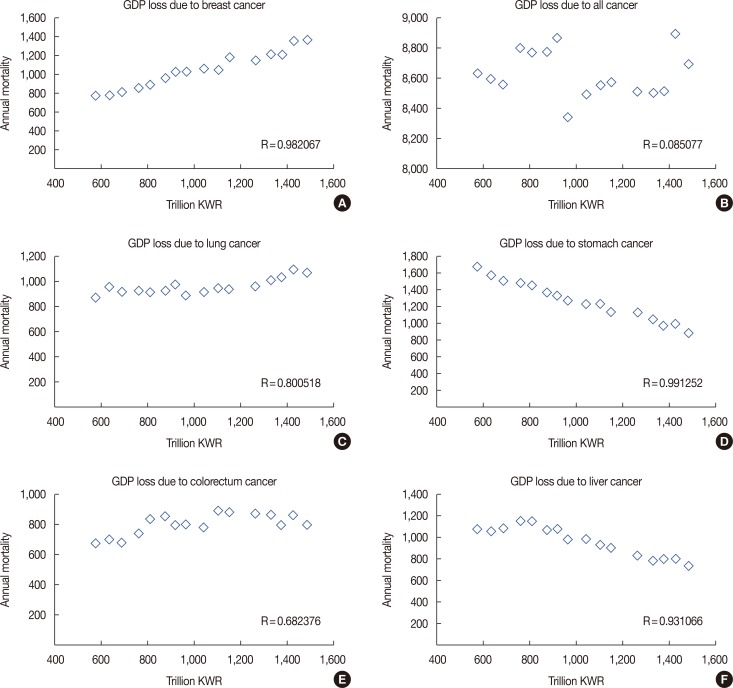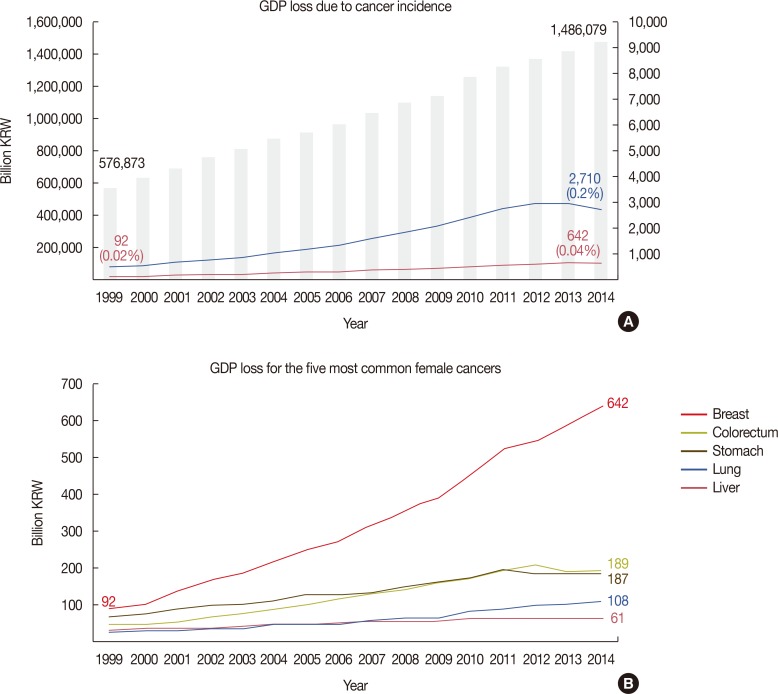This article has been
cited by other articles in ScienceCentral.
Abstract
In this study, we aimed to evaluate the economic loss due to the diagnosis of breast cancer within the female South Korean working-age population. A population-based cost analysis was performed for cancer-related diagnoses between 1999 and 2014, using respective public government funded databases. Among the five most common cancers, breast cancer mortality was strongly associated with the growth in gross domestic product between 1999 and 2014 (R=0.98). In the female population, breast cancer represented the greatest productivity loss among all cancers, which was a consequence of the peak in the incidence of breast cancer during mid-working age in the working-age population, in addition to being the most common and fastest growing cancer among South Korean women. Our study shows that breast cancer not only represents a significant disease burden for individual patients, but also contributes a real, nonnegligible loss in productivity in the South Korean economy.
Go to :

Keywords: Breast neoplasms, Costs and cost analysis, Employment, Female, Quality of life
From an economic standpoint, South Korea is an exemplary post World War success story, rising as one of the poorest countries in the world to a developed, high-income country within the life of a single generation. This economic growth over the past six decades has been followed by the epidemiol-ogic transition from malnutrition and infectious diseases to noncommunicable diseases as the leading causes of mortality, with cancer as the number one cause of death in South Korea [
1]. In South Korea, the majority of cancers peak in the seventh decade of life, which is well into the retirement age for most cancer patients, as is the case elsewhere in the developed world. However, the epidemiology of breast cancer in South Korea is significantly different from that of North American and European countries [
2]. In Western countries, the incidence of breast cancer peaks near retirement age. This is in contrast to the mean age of 45 to 51 years at the time of diagnosis in South Korea, which also coincides with the prime working-age population [
34].
In the clinical arena, the issue of premenopausal breast cancer within the Korean population has been studied and discussed in significant detail from a wide spectrum of perspectives, including the relatively high prevalence of young breast cancer (i.e., breast cancer occurring in patients less than 35 years of age) [
5678910]. From an epidemiologic point of view, breast cancer is the most prevalent cancer and is the second leading cause of cancer deaths in the female population [
11]. Despite this, breast cancer has been and continues to be considered as less of a priority in policy-making processes because of the high survival rate relative to other major cancers [
12]. However, survival rate and age-standardized mortality only allow a partial perspective of the cost of any given disease, and the societal impact of breast cancer may be greater from an economic perspective. Clinical and epidemiologic patterns single out breast cancer as the neoplasm that most affects the female working-age population in South Korea. To date, no study has looked at the impact that breast cancer has on the overall gross domestic product (GDP) of the South Korean economy. Our study evaluates the effect breast cancer has on the working-age population in South Korea and its overall impact on the GDP.
The burden of breast cancer in South Korea was evaluated in a population-based cost analysis. Cancer was defined by the World Health Organization International Classification of Diseases, 10th revision. Our analysis was performed for all cancers except thyroid neoplasms (C00–99) and separately for breast (C50), stomach (C16), colorectal (C18–21), liver (C22), and lung (C33–34) cancers, which represent the five most common solid tumor neoplasms in South Korea. Annual cancer incidence and mortality statistics were collected from the Korean Ministry of Health (National Cancer Center) [
13]. Relevant economic data was obtained from the Korean Statistical Information Service [
1]. The National Cancer Center data registry provided datasets from 1999 to 2014 at the time of this study. As such, the economic databases were queried for the respective period. The annual incidence and mortality of cancer were analyzed for the entire female population as well as for the working-age population in South Korea. The relationship between cancer mortality and GDP was evaluated for the female working-age population. The economic cost due to the loss of productivity was calculated using the annual cancer incidence as a proportion of the female working-age population. This calculation was performed for all cancers and separately for breast, stomach, colorectal, liver, and lung cancer. Each data set was evaluated using time series analysis, and correlations between continuous variables were analyzed using the Pearson correlation coefficient.
Within the working-age population, it was found that the all cancer mortality had decreased, consistent with the overall trend of cancer affecting patients in retirement age. Among the female working-age population, cancer-related mortality as a proportion of all-cause mortality decreased from 45% in 1999 to 30% in 2014. During the same period, the breast cancer-related mortality rose from 9% to 16% of all cancer-related mortality. The change in cancer-related mortality within the working-age population was analyzed in relation to the GDP growth over the period. For all-cancer related mortality, there was no discernable relationship between mortality rate and GDP (R=−0.09). Among the five most common cancers, only breast cancer mortality was strongly associated with the growth in GDP between 1999 and 2014 (R=0.98) (
Figure 1). Based on the incidence data, the economic loss (loss of productivity) was calculated for all cancers and for the five most common cancers. In 1999, the economic loss from all cancers amounted to 478 billion Korean Won (KRW). By 2014, the GDP loss due to all cancers had increased to 2,710 billion KRW, which represented 0.2% of the total GDP (
Figure 2A). In 2014, the pooled economic loss due to the top five most common cancers was 1,187 billion KRW. Among the five most common cancers, breast cancer was the leading cause of GDP loss (642 billion KRW), followed by colorectal cancer (189 billion KRW), stomach cancer (187 billion KRW), lung cancer (108 billion KRW), and liver cancer (61 billion KRW). During the period under review (1999–2014), the GDP loss rose from 92 billion KRW to 642 billion, where the latter figure represented 54% of all GDP lost due to the top five cancers (
Figure 2B).
 | Figure 1
Relationship between gross domestic product (GDP) at each common cancer. (A) GDP loss due to breast cancer. (B) GDP loss due to all cancer. (C) GDP loss due to lung cancer. (D) GDP loss due to stomach cancer. (E) GDP loss due to colorectum cancer. (F) GDP loss due to liver cancer. GDP analysis for all cancers demonstrates no discernable relationship to mortality (R=−0.09). Of the five most common cancers, only breast cancer has a direct correlationship to GDP (R=0.98), which is a consequence of most breast cancer cases occurring within the working-age female population.
KWR=Korean Won.

|
 | Figure 2Economic loss according to cancer incidence and five common female cancers. (A) Economic loss due to cancer incidence. Between 1999 and 2014, the productivity loss due to all cancers within the working-age female population grew from 478 billion Korean Won (KRW) (0.1% of total gross domestic product [GDP]) to 2,710 billion KRW (0.2%). During the same period, the productivity loss due to breast cancer grew from 92 billion KRW (0.02% of total GDP) to 642 billion KRW (0.04%). (B) Productivity loss for the five most common cancers. Within the working-age female population, breast cancer was associated with the greatest increase in productivity with a compound annual growth rate of 13.8%.
|
Our study represents the first of its kind to evaluate the loss of economic production due to breast cancer in South Korea. In our analysis, the total loss of productivity due to all types of cancer has increased steadily, from 478 billion to 2,710 billion KRW. This overall increase in productivity loss due to cancer is an apparent paradoxical product of economic growth over the past several decades in the country. With economic development, South Korea underwent rapid deployment of public health institutions as well as the widespread adoption of advanced healthcare systems [
14]. The consequence of this is a decrease in morbidity and mortality from infectious diseases within the working-age population; however, chronic, noncommunicable diseases are becoming more significant causes of illness-related productivity loss (net positive increase in productivity). The disproportionate rise in the incidence of breast cancer represented a significant loss of economic activity in the female population. In 1999, breast cancer was responsible for a loss of 92 billion KRW (0.02% of total GDP). By 2014, this figure had increased by more than a six-fold, to 642 billion KRW (0.04% of total GDP). In the female working-age population, breast cancer appears to be responsible for the greatest loss of productivity across various type of cancers in South Korea.
In the definitive study on the economic cost of cancer within the European Union, Luengo-Fernandez et al. [
15] reported that breast cancer was associated with the highest health-care cost at €6.73 billion and that its impact on the productivity loss was third highest, after lung and colorectal cancer. This difference between the European study and our own is most likely due to the fact that breast cancer more frequently occurs in the working-age population in South Korea. The overall economic impact should be understood in the context of how a breast cancer diagnosis affects the livelihood of South Korean patients who are usually at the peak of their economic activity. In a cross-sectional study of South Korean women of working age, Ahn et al. [
16] found that breast cancer patients are more likely to experience economic hardships due to unemployment and that this impact is greater for Korean breast cancer patients than those of Western countries. From both the macroeconomic and individual perspectives, breast cancer does appear to be a significant deterrent to economic growth for South Korea. The findings in our study warrant close attention to the state of breast cancer policy and management. Within South Korea, breast cancer generally occurs more commonly in the premenopausal population, and a significant number of these cases presents in patients younger than 35 years of age and are associated with more aggressive molecular phenotypes and worse prognosis [
617].
Our study does have some limitations in answering the true question of how breast cancer affects the individual patients, families, and the greater economy. The study provides sufficient macroeconomic perspective needed for policymakers but falls short of providing the whole picture as the data related to the cost of caregiving will require a more extensive study. Furthermore, the study does not analyze the secondary social costs of a breast cancer diagnosis in a central household figure, as the vast majority of South Korean patients are highly functioning individuals, not only at the workplace but also at home as a spouse and parent.
In conclusion, our study examined the productivity loss due to a breast cancer diagnosis within the working-age population in Korea. In the female population, breast cancer results in the greatest loss of productivity loss of all cancers, mainly because it is the most prevalent and fastest growing cancer among South Korean women and due to its incidence peaking during the period when women are at their prime of productivity. Further studies are warranted in assessing ancillary economic costs due to the role these patients hold in the workplace and at home. The increasing incidence of breast cancer is projected to increase the loss of productivity in the female working-age population, which stands in stark contrast to the fact that continued economic growth will require a further shift by the same population from nonmarket household production into the market of the tangible labor force in South Korea.






 PDF
PDF ePub
ePub Citation
Citation Print
Print


 XML Download
XML Download